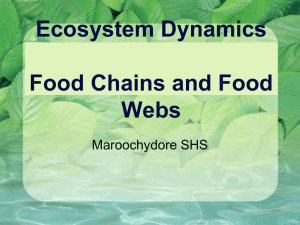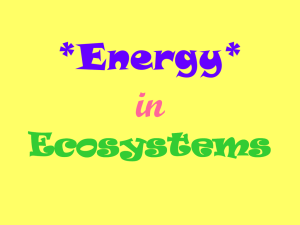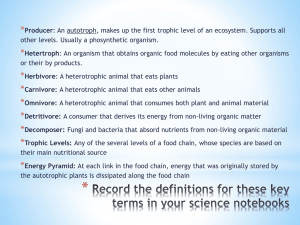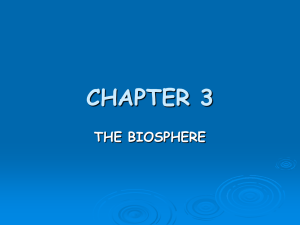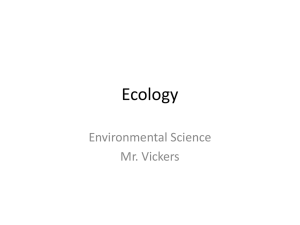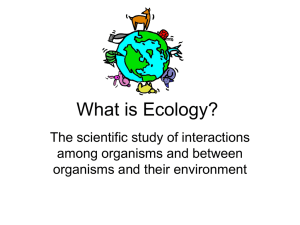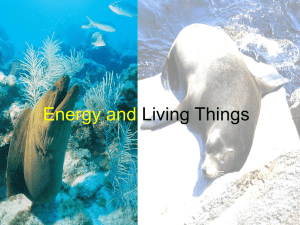Document
advertisement
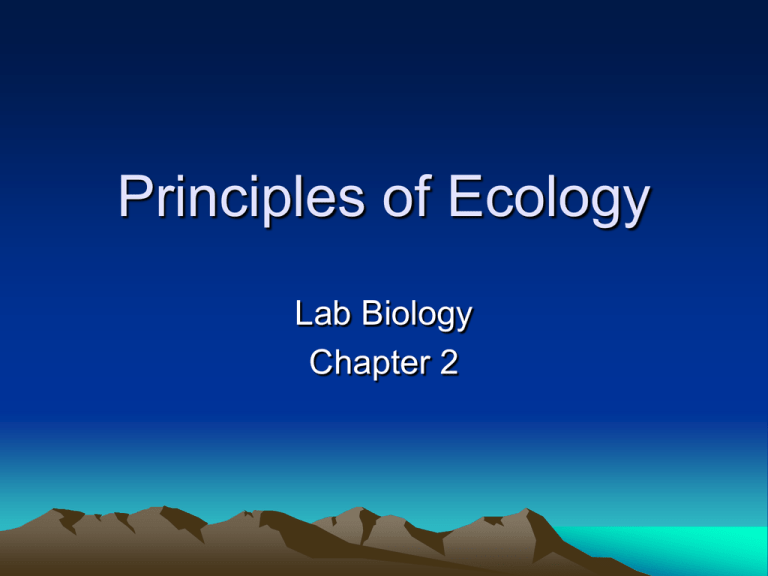
Principles of Ecology Lab Biology Chapter 2 Organisms and Their Environment • Ecologists study the way organisms live in their environment. • Biotic factors: living things • Abiotic factors: nonliving things The Biosphere • The biosphere is all of the area of Earth which can support living things, • including the air, land, and water. • Living things are affected by nonliving things and by other living things. Abiotic Factors • • • • • • Air currents Temperature Moisture Light Soil Abiotic factors determine what organisms can live in an area. Biotic Factors • All organisms depend on other organisms for: • food • shelter • reproduction • protection Levels of Organization • A species is a group of similar organisms which can successfully interbreed. • A population is a group of organisms of the same species in an area. • A community is a group of interacting populations. Levels of Organization, cont. • An ecosystem is all of the biotic and abiotic factors in an area, or: • all of the living things in an area and the conditions under which they live. Organisms in Ecosystems • A habitat is the place where an organism lives. • A niche is the way an organism lives in an area. Symbiosis • “Living together” • A close and permanent relationship between species • Most species survive because of the relationships they have with other species Symbiosis, cont. • Mutualism – both organisms benefit • Commensalism – one organism benefits, the other is not affected • Parasitism – one organism benefits, the other (the host) is harmed Predator/Prey • A predator seeks out another organism for food. • The prey is the organism which gets eaten. Nutrition and Energy Flow Producers: autotrophs make their own food Photosynthetic plants and green algae use energy from the sun to produce sugars Chemosynthetic bacteria use energy from chemical reactions to make nutrients Nutrition and Energy Flow, cont. Consumers: heterotrophs must eat other organisms to get their nutrition Herbivores eat plants Carnivores eat animals Omnivores eat both plants and animals Decomposers break down dead organisms into nutrients which are returned to the environment Flow of Matter and Energy in Ecosystems Carbon, nitrogen, and other elements pass from air and soil through producers to consumers and back into the air and soil. Food chains and webs show the direction of energy flow through trophic levels. Flow of Matter and Energy in Ecosystems, cont. A food chain shows a simple, linear pathway for movement of matter and energy. A food web shows the relationships between interconnected food chains. Arrows indicate the direction of energy flow. Mountain lions hawks snakes deer Second-order heterotrophs First-order heterotrophs mice rabbits Seed-eating birds autotrophs grass shrubs trees A food web illustrates the complex feeding relationships by which matter and energy move through an ecosystem. decomposers 1. At which level of the food web is the supply of energy the greatest? Explain. • The supply of energy is greatest at the level of the autotrophs – they are the most numerous organisms and get energy directly from the sun. 2. Which feeding relationship do first–order heterotrophs have in common? • They are all herbivores, or plant-eating animals. 3. Which feeding relationship do second–order heterotrophs have in common? • They are all carnivores, or meat-eating animals. 4. Explain why plants are called autotrophs. • “Auto” is Greek for “self”. Since plants make their own food during photosynthesis, they are called autotrophs. 5. Food webs and food chains both involve multiple trophic levels. How do they differ? • Food chain: depicts a single sequence of feeding relationships. • Food web: represents a network of interrelated food chains. 6. Use the transparency to describe a food chain that includes a mountain lion and a shrub. • The mountain lion might feed on a deer or mouse which has fed on shrubs, which depend on decomposers (bacteria and fungi) to recycle nutrients from dead organisms. 7. How might the organisms pictured in the food web be affected if most of the mouse population was destroyed by disease? • Other 1st-order heterotrophs, such as birds, rabbits, and deer, would have more food. All the 2nd-order heterotrophs pictured would experience increased competition for the remaining food sources, and those food sources might become depleted sooner. Top carnivores carnivores carnivores herbivores producers herbivores Pyramid of energy Pyramid of numbers Producers Hawk 1 Robins 90 Grasshoppers 200 Grass 1500 Pyramid of Biomass 1. What is the source of energy for all of the ecological pyramids shown in the transparency? • The sun 2. In general, what kind of organism makes up the base of the pyramid of energy? Provide some specific examples. • Autotrophs/producers, such as grass, trees, or algae 3. Examine the pyramid of energy shown in the transparency. Explain why only about 10% of the energy available at one trophic level is transferred to the next higher trophic level. • Not all of the available food is eaten. • Not all of the food eaten is digested. • Some of the energy in digested food is used for metabolism (chemical reactions used for life). • A lot of the energy is lost as heat. 4. How is the energy loss from one trophic level to the next reflected in the pyramid of numbers shown in the transparency? • Each higher trophic level in the energy pyramid has a smaller number of larger organisms, showing that the energy available to successive levels diminishes. 5. Suppose an ecosystem has a greater number of individual herbivores than individual producers. How would this affect the shape of the ecosystem’s pyramid of numbers? • The pyramid would be inverted – the top level would be wider than the bottom. • Example: ants on an acacia tree. 6. What quantity does a pyramid of biomass express? • The total dry weight of living materials at each trophic level. 7. Explain how biomass is calculated. • The average weight of a species is determined and then multiplied by the estimated number of organisms within the population at that level. Burning of fossil fuels CO2 in atmosphere Photosynthesis Precipitation Industry and agriculture Respiration Death, decomposition Diffusion Photosynthesis CO2 dissolved in water Calcium carbonates in rocks and shells Carbon compounds converted to fossil fuels 1. What is the process by which plants convert carbon dioxide into energy-rich carbon compounds? Photosynthesis 2. Explain what can happen over millions of years to the carbon compounds in organisms that die and decompose. They may be converted into fossil fuels (coal, oil, natural gas) 3. What processes in the transparency release carbon dioxide into the atmosphere? Respiration, decomposition, diffusion of CO2 from water to air, burning of fossil fuels 4. Identify the two major reservoirs of carbon dioxide on Earth. The air and the oceans 5. What are the forms in which carbon is found in the oceans? Dissolved CO2; carbon compounds in the bodies of fish, etc.; calcium carbonate in rocks and shells 6. How do plants and animals help to maintain a balance of carbon dioxide in the atmosphere? Plants remove CO2 from the atmosphere during photosynthesis. Plants and animals return CO2 to the atmosphere during respiration. 7. Atmospheric carbon dioxide might produce a so-called “greenhouse effect” by trapping heat near Earth’s surface. What human activities might tend to increase the greenhouse effect? Destruction of plants, especially forests; burning of fossil fuels to produce energy for industry, agriculture, and transportation The Nitrogen Cycle – a series of chemical changes in which bacteria change nitrogen into a form plants and animals can use, and change it back after plants and animals die. N2 NH3 NO3- 1. What percent of the air consists of nitrogen gas? 78% 2. Bacteria in root nodules change nitrogen gas into what form? ammonia (NH3) 3. What is the role of decomposers in the nitrogen cycle? Decomposers break down nitrogen-containing molecules in dead organisms into ammonia. 4. How do plants obtain the nitrogen they need? Bacteria in soil convert ammonia to nitrates (NO3-) which plants use to make nitrogen-containing molecules (proteins). 5. How do herbivores obtain the nitrogen they need? Herbivores obtain nitrogen from the proteins in the plants they eat. 6. How do other animals obtain the nitrogen they need? Carnivores obtain nitrogen from the proteins in the animals they eat. 7. According to the transparency, how is nitrogen returned to the atmosphere? Bacteria change nitrates (NO3-) in the soil into nitrogen gas (N2). 8. What would be the impact on the nitrogen cycle if there were a decrease in decomposition in a given ecosystem? Less nitrogen would be cycled to the atmosphere so less would be available to organisms.
